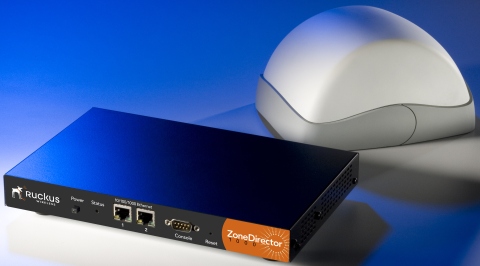Ruckus brings smart antennas to the enterprise wireless LAN space

Ruckus Wireless launched a new line of products for the small to mid enterprise wireless LAN space. Ruckus was a maker of smart antenna technology specializing in smooth and reliable data delivery for IPTV applications but now they are extending this technology to the enterprise space. In addition to smart antenna technology, Ruckus also implements wireless bridging and mesh technology in to these products. Soon to follow will be 802.11n and dual-band 2.4/5 GHz access points. See larger image gallery here.
Ruckus is going after the small to medium wireless LAN with a very simple web interface. Based on the demos I've seen, it doesn't require a lot of tweaking or a high degree of expertise with wireless LAN technology. Four virtual access points for commonly used applications like guest, voice, and internal access are preconfigured and the administrator just needs to tweak a few settings such as priority.
The higher-end Ruckus 2942 is designed to be ceiling mounted although it can be mounted against a wall since its antennas can propagate horizontally or vertically. It features an ordinary FastEthernet port or an 802.3af PoE (Power over Ethernet) port. That bulge on top houses the smart antenna that automatically optimizes its configuration for the node it's communicating with. For extra flexibility, the 2942 also features an RP-SMA external antenna connector.
This is the smart antenna for the Ruckus 2942 access point. It features antennas that cover not only the horizontal direction but also the vertical direction which can form a directional beam equivalent to a 9 dBi antenna. Coupled with the intelligent controller, the administrator simply needs to spread a few access points out based on user density and they don't need to worry about spectrum management or complex and costly antenna installations.
Smart antenna technology The benefit of a smart directional antenna is that it only amplifies to a single direction towards the device it's talking to and not to anyone else. Omni-directional antennas amplify signals in all directions for receive and transmit which makes them more susceptible to receive noise and more likely to generate noise for other devices. Wireless signals coming from other devices from other directions will reduce the signal to noise ratio on a dumb omni-directional antenna but not on a smart directional antenna. I've witnessed the efficacy of such a system first hand when I saw unbuffered UDP streaming video on a laptop sitting next to a noisy microwave oven and the smart antenna solution was able to overcome the problems while the dumb omni-directional antenna simply failed to deliver video.
In theory, it is possible to get a similar improvement using dumb directional antennas but that improvement is only aimed at a single direction. Putting a mechanical rotation device on a fixed directional antenna can solve the direction problem but it's very costly and complex and it can't possibly change directions thousands of times a second to adjust to multiple clients. The smart antenna uses an array of antennas facing a wide range of directions and software logically points the antenna by only using the portions of the antenna that generate the highest signal to noise ratio.
